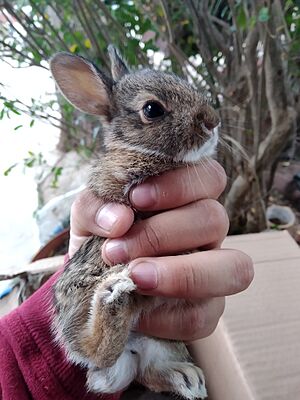Mexican cottontail facts for kids
Quick facts for kids Mexican cottontail |
|
|---|---|
 |
|
| Conservation status | |
| Scientific classification | |
 |
|
| Mexican cottontail range | |
| Synonyms | |
|
Lepus cunicularius Waterhouse, 1848 |
The Mexican cottontail (Sylvilagus cunicularius) is a type of cottontail rabbit. It belongs to the Leporidae family, which includes rabbits and hares. This rabbit lives only in Mexico. Its favorite places to live are cool forests, dry tropical forests, and grassy fields.
Contents
About the Mexican Cottontail
The Mexican cottontail was first described by an English scientist named George Robert Waterhouse. He studied it in 1848. He was working on classifying animals at a museum in London.
Scientists recognize three different types, or subspecies, of the Mexican cottontail. These are Sylvilagus cunicularius cunicularius, S. c. insolitus, and S. c. pacificus.
What Does It Look Like?
The Mexican cottontail is one of the biggest rabbits in its group. It is also the largest rabbit found in Mexico. These rabbits usually weigh between 1,800 and 2,300 grams (about 4 to 5 pounds).
Their fur is rough and can be reddish-brown or grayish-brown. Their bellies are white. As they get older, their fur becomes a lighter, yellowish-gray color.
Mexican cottontails are about 48.5 to 51.5 centimeters (19 to 20 inches) long. Their tails are short, about 5.4 to 6.8 centimeters (2 to 2.7 inches) long. Their back feet are about 10.8 to 11.1 centimeters (4.2 to 4.4 inches) long. Their ears are about 6 to 6.3 centimeters (2.4 to 2.5 inches) long. Rabbits living in the Sierra Madre de Oaxaca mountains are often a bit bigger than others.
How Do Mexican Cottontails Live?
Mexican cottontails can have babies all year round. However, they have the most babies during the warm and wet summer months. This period is usually from March to October.
Reproduction and Life Cycle
Before giving birth, mother rabbits dig a special nursery burrow. This burrow is a short, shallow tunnel, usually about 23 centimeters (9 inches) long. It ends in a small room about 17 centimeters (6.7 inches) below the ground.
Mothers build nests inside these burrows. They use materials like dry grasses, pine needles, and small pieces of woody plants. They might also add oat straw and alfalfa hay. These materials can also be extra food for the babies.
The mother feeds her young at the entrance of the burrow. She does this until the babies are about 12 days old. Once the young rabbits are old enough to be on their own, the mother closes the burrow entrance. The way Mexican cottontails dig burrows is similar to how European rabbits and pygmy rabbits dig. Other cottontail rabbits usually do not dig such detailed burrows.
Where Do They Live?
The Mexican cottontail lives only in Mexico. Its home range stretches from the state of Sinaloa all the way to Oaxaca and Veracruz. This includes the mountains of the Trans-Mexican Volcanic Belt. They can live from sea level up to very high places, about 4,300 meters (14,000 feet) high.
Habitats and Environment
These rabbits live in many different types of places. This includes tropical, temperate, and dry deciduous forests. They also live in thick shrubland, grassland, and even in areas where humans have farmed or disturbed the land.
In central Mexico, they are very common in pine and pine/oak forests. They like areas with clumpy grasses like Agrostis, Festuca, and Muhlenbergia on the ground.
Who Hunts Them?
Many animals hunt the Mexican cottontail. Their predators include red foxes, coyotes, long-tailed weasels, and feral dogs. Birds of prey like the great horned owl and the red-tailed hawk also hunt them.
Status of the Mexican Cottontail
The Mexican cottontail is common throughout the areas where it lives. Because of this, the IUCN (International Union for Conservation of Nature) lists it as a species of least concern. This means it is not currently considered endangered.
For example, in the La Malinche National Park, there are about 27 Mexican cottontails per square kilometer. However, their numbers might be decreasing in some places. This can happen where people hunt them or where their habitat is being damaged. Too much overgrazing by other animals can also harm their homes.


